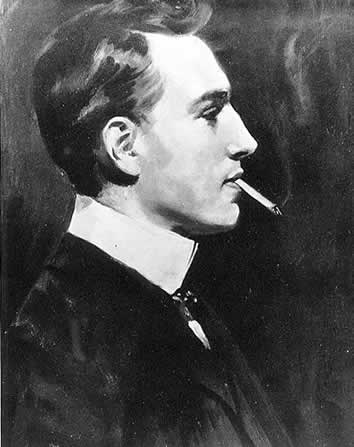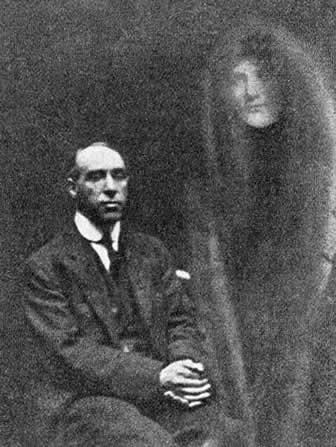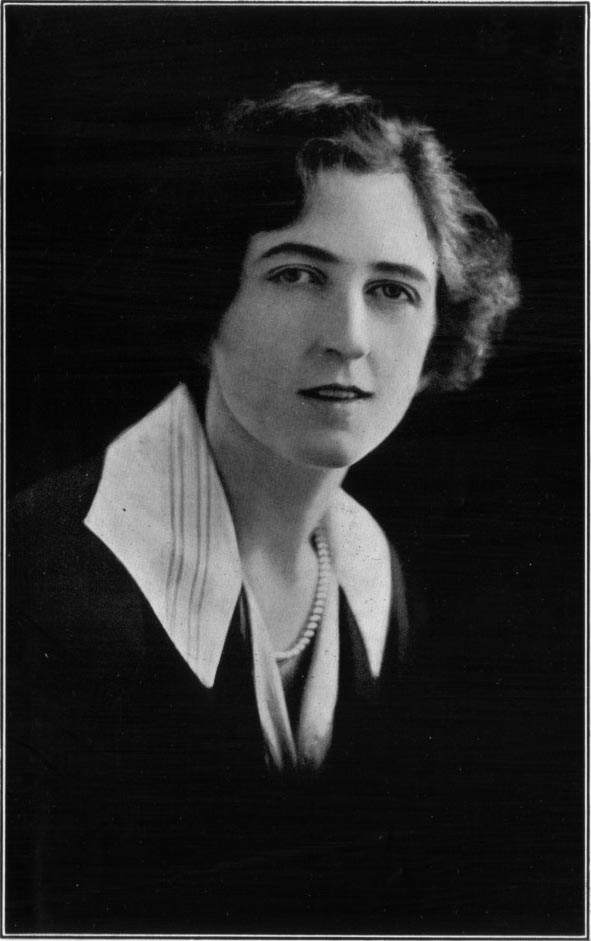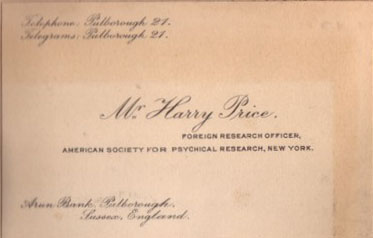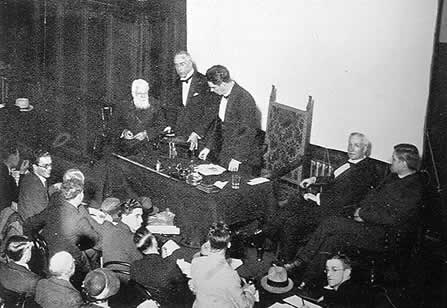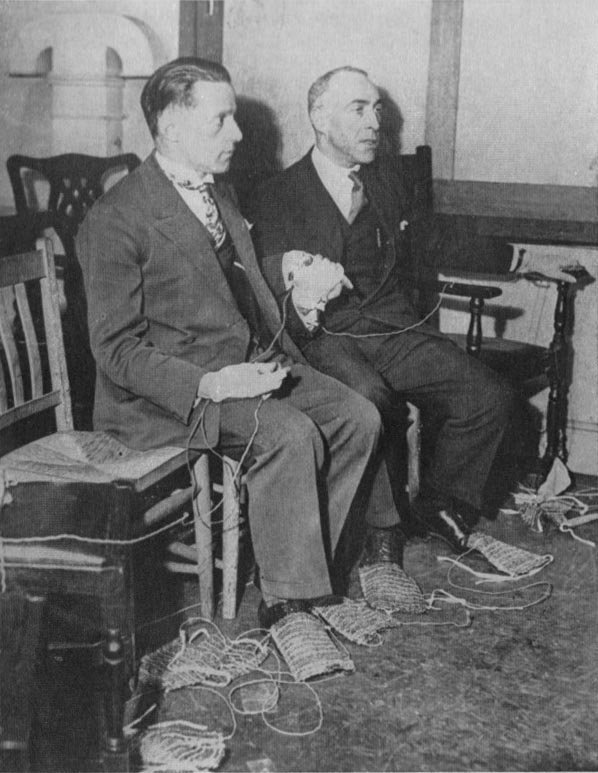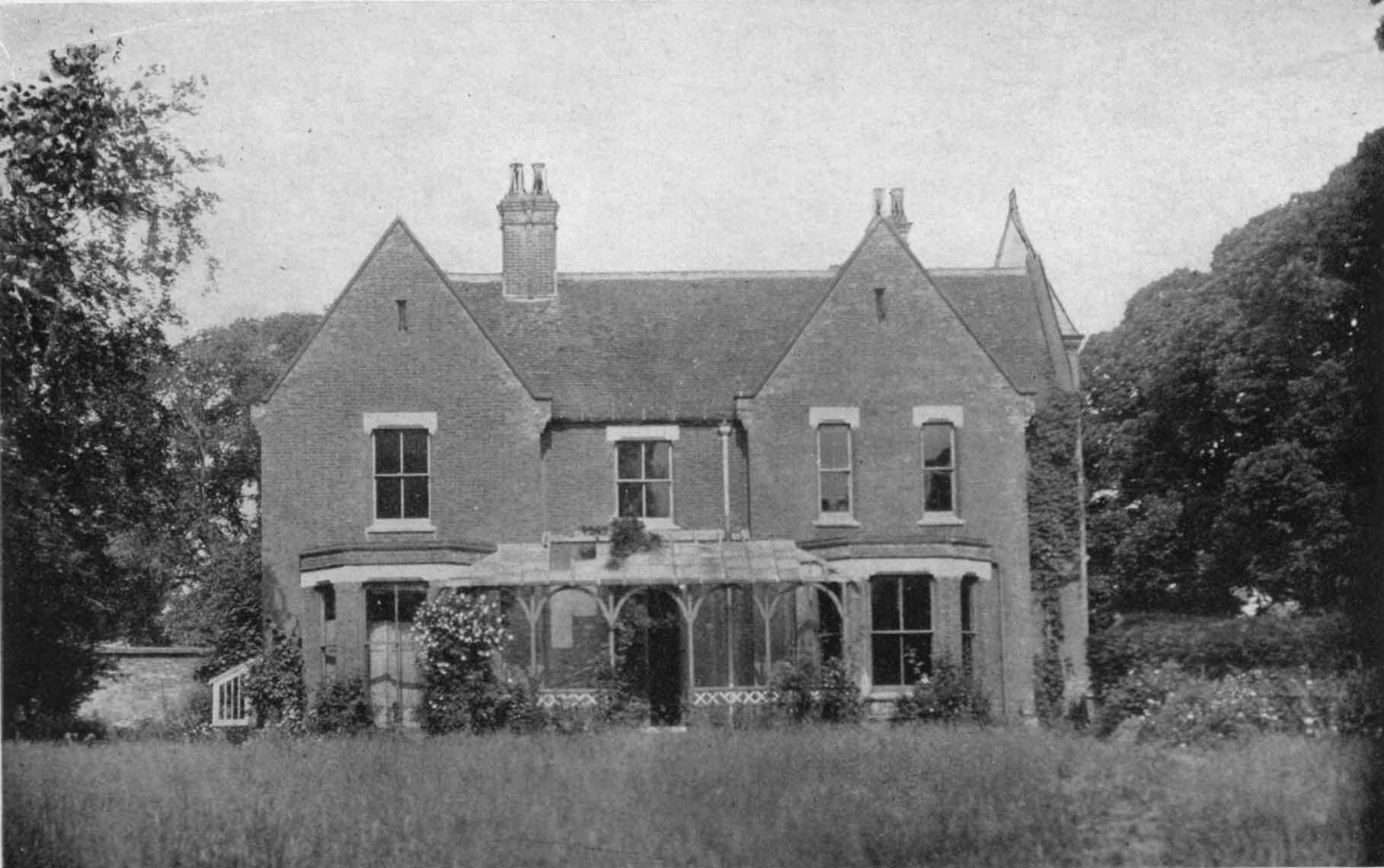|
Biography |
|||||||||||||||||||
|
|
Harry Price was born on 17th January 1881 at 37 Red Lion Square in Holborn in London. His father was Edward Ditcher Price, a 47 year-old commercial traveller and former grocer originally from Roddington in Shropshire. Price's mother was the much younger Emma Randall Price, formerly Meech who was fifteen when she married Harry's father at St. Andrew's Parish Church in Holborn on 11th January 1876. She was also pregnant at the time with Harry Price's sister who was born a few months after the marriage on 23rd April. From Holborn the Price family moved around 1885 when Harry was quite young to 6 Amersham Road, New Cross in South London and at the age of eleven in January 1892 Price started attending Haberdashers' Aske's Hatcham Boys' School in nearby Pepys Road. During his school days the Prices moved house once more to another address in New Cross, 32 St. Donatts Road in 1894. Price left school around 1897 or 1898 and in the ten years before he married in 1908 had several varied occupations but in the main followed his father's later career as a commercial traveller. In 1903 he was marketing a remedy for the cure of foot rot in sheep, while at another time he was involved in a partnership known as Price & Creasy which manufactured and sold a range of glues & adhesives which went under the collective title of 'Quexol'. Both these two ventures were operated out of the Price family home in St. Donatts Road. There was also a period when Price was employed taking advertising photographs of the shop fronts of various local premises in the New Cross neighbourhood. The years following Price's school leaving were busy ones as apart from earning a living Price was involved in other various activities. Goldsmiths' College is directly adjacent to St. Donatts Road and here Price attended evening classes in such subjects as photography, engineering and chemistry. He also possessed an American-made gramophone and around fifty records of classical pieces, American negro spirituals & band music and gave recital evenings around the country. During this time he was also something of an amateur playwright, contributing a three act farcical comedy called The Sceptic to an evening of songs, recitations & musical sketches at the Amersham Hall, New Cross in December 1898. Around this time Price began attending evening spiritualist meetings and also took part in some private séances. He also experienced what he would later describe as his first real Press interviews soon after his eighteenth birthday. This followed a successful wireless experiment that Price carried out on 22nd April 1899 when with portable home-made equipment he was able to record signals sent from a transmitter stationed on Telegraph Hill in Hatcham to a receiver about a mile away in the tower of St. Peter's Church in Brockley. Accounts of the experiment appeared in the local papers as well as the Westminster Gazette. As well as amateur dramatics Harry developed an interest in numismatics and it was in this field that he produced his first published writings in two newspapers, The Kentish Mercury and The Wellington Journal, the latter being a Shropshire paper. The Coins of Kent and Kentish Tokens was published serially between 1902-1904 in the Mercury while a shorter series, the Shropshire Tokens and Mints appeared around the same time in the Journal, Price basing his numismatic articles on standard text books of the times. Through his interest in coin collecting Price was elected as the Curator of Numismatics to the Ripon Naturalists' Club and Scientific Literary Association on 18th May 1904. The Club and Association was based for a time at the Museum in Park Street, Ripon before moving to other premises. Harry Price's mother Emma was only forty-two when she died of cancer on 18th August 1902 in St. Thomas's Home in Lambeth and he lost his father four years later from heart failure on 7th July 1906. Price's sister Anne was by this time married and living in a house in Waller Road, Hatcham (1). Following his father's death Harry may have lived with her for a time, but there is evidence that he lodged with a lady called Mrs Hills at 22 Harefield Road in Brockley, a district just to the south of his old stomping ground of New Cross (2). This address in Brockley is about half a mile north of 10 Adelaide Road which was the family home of Harry Price's future wife Constance Mary Knight whom he married on 1st August 1908. Their wedding took place in the Parish Church at Pulborough in West Sussex - Constance's father Robert Hastings Knight had died of a brain tumour five months before Edward Ditcher Price on 2nd February 1906 and his widow, Mary Ann Knight had moved to Riverside, an address in Pulborough following his death. The Knights were a somewhat affluent family which stemmed from the business dealings of Constance's grandfather Robert Henry Knight, a London perfumer & property owner. A considerable trust fund which included the revenue from government securities and a substantial amount of property was willed by Robert Henry to his three children Emma Thomazine Knight, Amelia Mary Knight & Robert Hastings Knight and the subsequent heirs to this fortune on Robert Hastings' death were Constance herself and her brother, another Robert Henry Knight. Following their marriage, Harry and Constance Price made the Sussex town of Pulborough their new home and their house, the aptly named Arun Bank, so called because a two hundred yard stretch of the riverbank of the River Arun formed one of the boundaries of the property was to be the one that they shared for the next forty years. It is commonly stated that the financial security that the income from Constance Price's trust fund gave the Prices enabled Harry to devote himself to his various interests and ambitions, one of which was to possess the largest library of magical literature in existence. However, like many of the areas of Price's life, this is debateable. S.P.R. member John Randall, who has spent a considerable amount of time researching into Price's life in the Harry Price Library at the University of London disagrees with the notion that Constance Price funded Harry's work and collecting, and this notion has also been the subject of objection from members of the Knight family over the years. Price had become interested in archaeology during his days in New Cross and this continued after he had moved down to West Sussex, delivering a lecture entitled Roman Pulborough about the excavation of a villa at Borough near Pulborough which was reported in the Sussex Dailey News on 29th December 1909. In the summer of the previous year he assisted the inventor José Weiss for a day in carrying out a series of flying tests with experimental gliders at Amberley Mount, a point on the South Downs. His interest in amateur dramatics was also rekindled for a musical adaptation of Bunyan's Pilgrim's Progress which as actor-manager he produced for five performances in Pulborough and Horsham. This was in 1910, the same year that he contributed a series of articles on antiquarian subjects to the Southern Weekly News newspaper.
Early on in his autobiography Search for Truth, Price describes his real leisure activities as the collection of books on magic and the 'unravelling of the apparently miraculous'. Since his early teenage years he had witnessed first hand the activities of fairground psychics & vaudeville mediums and had developed a good knowledge of the conjuring and methods of deception which these performers used in their acts. In the years following his marriage in the run-up to the beginning of the First World War he continued to attend music hall shows, spiritualistic meetings & séances, such as the sittings given by the Tomsons, a husband & wife duo who described themselves as 'American materialising mediums' at the Alhambra Music Hall in Leicester Square in the summer of 1910. Harry Price was in his early thirties at the start of the First World War. He and his wife were holidaying in Paris at the beginning of August when hostilities began and in his autobiography he describes their adventure of getting back to England by train and steamer, which included witnessing the shooting of a German spy who apparently attempted to blow up the bridge over the River Oise on which the Prices' train had halted. It was at this time that Price made the intention to establish a laboratory in which mediums and psychics could he scientifically tested to ascertain the truth of their claims. A heart condition precluded any active service on Price's part during the conflict and he served his country by putting his engineering background to good use. After initially trying to assist the Royal Flying Corps (later to be known as the Royal Air Force) with coloured filters in connection with aerial photography, Price spent the rest of the war years manufacturing shell fuses, at first in his own workshop at his home in Pulborough where with two assistants he turned out nearly 1000 fuses a month. After a year he was asked to supervise the night-shift at the J.J. Elliot clock factory in Gray's Inn Road, Tottenham which had been converted to war work and he remained there until the end of the War, manufacturing fuse mechanisms and parts of the Mills hand grenade. Price's uneasy relationship with organised psychical investigation began in June 1920 when he was elected a member of the London Society for Psychical Research. He remained a member of this organisation right up until his death and spent a good deal of time at the Society's rooms, making available his library of magical and occult literature for the use of its members. However, Price had already decided that he would reorganise British psychical research on his own terms and was waiting for the opportunity to make this happen. In the meantime he bided his time in a collaborative project with Eric J. Dingwall, producing a facsimile reprint of the late nineteenth century American spirit de-bunking handbook Revelations of a Spirit Medium.
His first major solo success took place in February 1922 with the high-profile exposure of the 'spirit' photographer William Hope of the notorious 'Crewe Circle' of spiritualists. Price turned up for his appointment for a sitting at the British College of Psychic Science armed with a prepared set of photographic plates. When Hope switched Price's plates for his own in the dark room, a slight of hand which was noted by the amateur conjuror, Price was able to publish a concise report in the Journal of the Society for Psychical Research denouncing Hope as a fraud. This caused a furore in spiritualist circles as Hope was highly regarded and it opened up a rift between Price and Sir Arthur Conan Doyle, the creator of Sherlock Holmes and an ardent Spiritualist, which continued on and off right up until Doyle's death in 1930. Harry Price decided that his Hope exposure needed a wider circulation in order to educate the public at large into the ways of the fakers and his Cold Light on Spiritualistic Phenomena appeared shortly afterwards as an offprint published by Kegan Paul. The year 1922 also saw Price's first experiences with the Austrian physical medium Willi Schneider when he was invited by Eric Dingwall to a series of sittings organised at the Munich home of Schneider's benefactor, Baron von Schrenck-Notzing. Both Price and Dingwall were impressed with the phenomena they witnessed in Schrenck-Notzing's séance room and signed statements testifying to the effect that Willi was a genuine medium. Price appeared to now be on something of a roll. His successes continued into the following year with the discovery of the young British medium Stella Cranshaw (Stella C) with whom he struck up a conversation on a train travelling back to his home in Pulborough. Price came to the conclusion that Stella's paranormal experiences signified that she was in fact a medium and he lost no time in arranging for her to carry out a series of sittings under his direction. It was the opportunity he had been waiting for. Rather than involve the S.P.R., Price booked the séance room of the London Spiritualist Alliance and the first sittings began in March 1923. For the first time he had the opportunity to carry out a series of experiments completely under his own control and he developed pieces of test equipment in his own workshop specifically to be used during these sittings.
Harry Price later credited the Stella C. séances as beginning the work of his own psychical research organisation which would later come to be known as the National Laboratory of Psychical Research. The first series of Stella C. sittings, thirteen in all, continued until October with impressive results and Price's report on the phenomena was published the following year in the Journal of the American Society for Psychical Research. August 1923 also saw Price take part in an International Congress for Psychical Research in Warsaw where he had the opportunity to sit with a number of mediums, one of whom, Jean Guzik was exposed as a fraud the day after his sitting with Harry Price. However, on his return to England the link with his numismatic interests of his early years was broken when his collection of rare coins was stolen from a display in Pulborough Church and he never returned to this field again. Compared with the highs of 1923, the following year was something of a fallow one for Price. He made an attempt to interest the B.B.C. with a scheme for broadcasting a series of telepathy experiments, but it was not until 1925 that Harry Price's reorganisation of British psychical research began to take on permanent shape. He spent the opening month on a Scandinavian lecture tour as a replacement for Conan Doyle who had been advised not to attend due to a warning received during a séance. Price's reputation in psychical matters had increased now to the point that he was able to open an International Psychic Exhibition in Copenhagen on the 10th January 1925 and also in Copenhagen was received as the guest of the Danish Rifle Club. Back home Price saw the realisation of his ambition, made at the outbreak of the Great War, finally come to fruition when on 25th March he chaired a meeting at the Royal Societies Club to inaugurate his National Laboratory of Psychical Research. At this event the future Council of the organisation was formed and soon after Price arranged to rent the top floor of the London Spiritualist Alliance's headquarters at 16 Queensbury Place, South Kensington as his centre of operations. The rest of 1925 proved to be a busy time. In the months following the inauguration, Price began putting his laboratory together and purchasing equipment and materials to set up what he would later describe as a "model psychic laboratory". Despite this, he returned twice to Austria for further sittings with Willi Schneider, on the second trip at the end of October meeting Willi's brother Rudi for the first time. In addition to all this, on the strength of his Stella C. report, which had been published in book form by Hurst and Blackett at the beginning of the year, in June Price had been appointed Foreign Research Officer for the American Society for Psychical Research, a post which he was to hold until 1931 when it was abolished as part of internal changes within the organisation. This appointment resulted in many contributions by Price to the A.S.P.R.'s Journal over the next few years.
On the 1st of January 1926, the new National Laboratory of Psychical Research opened in South Kensington in a blaze of publicity. Price and his organisation was reported on widely in the Press, a relationship which would be inseparable from then on. In April 1926, Price travelled to Austria to hold his first sittings with Rudi Schneider in his family home at Braünaü-am-Inn, and the following month he visited Vienna University at the invitation of Prof. Hans Thirring to deliver a lecture on scientific psychical research. This trip also resulted in his first experiments with the Rumanian "poltergeist girl" Eleonore Zugun who came to London later in the year accompanied by her benefactor, the Countess Wassilko-Serecki, for further experimental work at the National Laboratory. Price's report on Eleonore Zugun's phenomena formed the first part of the initial volume of the Laboratory's Proceedings which was published at the beginning of the following year. The year 1927 saw Price reinforce his international position in psychical research with a visit to Paris in January to carry out a sitting with Jeanne Laplace and a second lecture tour in June of the Scandinavian countries. During this latter trip, Price was the guest in Norway of Judge Ludvig Dahl at his home in Fredriksstad, although he was more impressed with the Judge's hospitality than the séance held with his married daughter, Fru Køber. In the same month there were more lectures, this time at Oslo University where the subject was the mediumship of the Schneider brothers and in Copenhagen, Prof. Winther organised two sittings with the daylight medium Anna Rasmussen whose phenomena Price found convincing.
On his return to England in July, there occurred one of Harry Price's famous publicity episodes with the opening at the Church Hall, Westminster of the locked "box" of the eighteenth century prophetess, Joanna Southcott. The wooden box had been delivered to the National Laboratory at the end of April and in the month before Price left the country for his lecture tour, he arranged for the box to be psychometrised by several mediums including Stella Cranshaw and Eileen Garrett. Their results were compared with the actual contents ascertained before the public opening by X-ray, and these together with the box itself became part of the museum of artefacts which Price kept as part of the National Laboratory. Price's other main outing in 1927 was to attended a Congress for Psychical Research in Paris, where on the 27th September he gave a lecture at the Sorbonne on the thermal variations recorded during the Stella C. sittings. Over the Christmas period, Price became aware of apparent poltergeist disturbances at a house in Eland Road, Battersea in South London, and after the "Battersea poltergeist" had become headline news in the January of 1928, he decided to investigate the case himself. The case caused immense public interest but overall, Price found it interesting but not convincing, while the incidents of moving objects which occurred when Price himself was in the house have been used by subsequent commentators on Price's work after his death as examples of his practice of 'helping the ghosts' at times. From Battersea, Price moved across London to carry out a séance at the Adelphi Theatre, home of the famous 'Man in Grey' on March 14th, although the reason for his visit was to investigate alleged paranormal phenomena in a dressing room formerly occupied by the actor William Terriss who was stabbed to death in the theatre in December 1897. Although it was stated that a mirror in the haunted room had been tapped from behind and that thumps had occurred when an actress had been resting on a couch, Price concluded that if there had been any activity it had ended prior to his visit. There were further international engagements later in the same year. In July, Price returned to Paris for a further sitting with Jean Laplace at the Institut Métapsychique where he also delivered some lectures. At the sitting Price handed the medium a folded letter he had recently received from Dr R.J. Tillyard who was an Honorary Vice-President of the National Laboratory and Mlle. Laplace gave several impressions she received about the writer, one of which was that the person would die in a tragic accident. Many of the impressions were correct and Price reported on the sitting in the Journal of the American Society for Psychical Research. The sequel took place nearly ten years later on January 13th 1937 when Dr Tillyard was killed in a car crash near Canberra, Australia, his death being in the exact way that Jean Laplace described. Harry Price had one further trip aboard during 1928 and this was to Italy where in the catacombs of Saint Agnes and Saint Calixtus in Rome, the resting place of many millions of early Christians, he carried out an experiment with a local medium in an attempt to pick up whatever psychic "emanations" may be present. The girl's vivid impressions formed the basis of a lantern slide lecture which Price delivered at the National Laboratory on his return to London. Price was now forty eight and his well established career in psychical research, involving much foreign travelling, was now beginning to show signs of affecting his health. Some time in 1928 he had his first attack of angina pectoris, caused by a temporary loss of blood supply to the heart muscle, a sign that he was overworking himself, and the condition of Price's health would later on become a factor in the direction that his work was to take in the next few years.
The following year, 1929, was an important one for Price as it contained two important landmarks in his public career as an international psychical researcher. The first came in April when he completed a lengthy series of negotiations which enabled Rudi Schneider to visit London for the first time, holding the first series of sittings under Price's direction at the National Laboratory. These were very successful and Price was impressed with the phenomena witnessed under his own controlling methods, a development of the 'electric control' system originally employed by Baron von Schrenck-Notzing and Karl Krall in Munich. Schneider returned to London in November and the second block of séances continued through until the middle of the January of the following year. As these sittings progressed, Price was convinced that Rudi was a genuine medium and the experiments with the young Austrian mechanic were reported on widely in the British Press at that time. Indeed, Price issued a £1000 challenge in the Evening Standard on December 3rd to any professional magician able to duplicate the phenomena produced by Rudi Schneider under the same control conditions as were employed at the National Laboratory. There were no takers and Price followed this up a week later when he visited the Coliseum Music Hall in London where Noel Maskelyne, the stage magician was performing. Price stopped the proceedings and challenged the conjuror again to replicate the Schneider phenomena, offering a further £500 if it was produced under the same conditions as the recent sittings. Again the offer was refused. The second landmark in 1929 for Harry Price occurred on June 11th when through the Editor of the Daily Mirror newspaper he heard of Borley Rectory for the first time. Probably the most controversial case in the whole of Price's career in psychical research had begun. Price, together with his secretary, Miss Lucy Kaye, visited the Rectory the next day where they were received by the then incumbent, the Rev. Guy Smith and his wife, together with Mr V.C. Wall, a reporter for the Mirror newspaper whose articles concerning the apparent hauntings at the lonely Essex rectory were making headlines. Price stayed at Borley for three nights where he experienced objective phenomena, particularly of the poltergeist type which has lead his later detractors, as in the Battersea case, to surmise that he was actively helping the haunting along, this time in the employ of the Editor of the Daily Mirror in order to improve circulation for his paper. It has to be said that up until this time, the haunting had been a far less physical one, taking the form of the apparition of the now famous 'Nun', together with that of a phantom coach and four, a mysterious window light and auditory phenomena such as footsteps inside the building itself, although to be fair to Harry, poltergeist phenomena had been reported before, however much earlier on during the time that the Bull family, the builders of the Rectory, were resident, particularly in the closing years of the nineteenth century.
Price made several visits to Borley during June and July, at one of which on July 25th, occurred the "Now I have got you" episode in which the newspaper reporter Charles Sutton, who accompanied Price and Miss Kaye on this occasion, stated several years later after Price had died, that he caught Price playing at being a poltergeist with a pocket full of stones. What actually went on at this particular visit has been hotly debated over the years, but what seems clear is that Price suffered another angina attack following Sutton's challenge and was unable to attend a further visit with Lord Charles Hope to the Rectory on the night of the 28th/29th July due to illness when Miss Kaye represented him. Price would later acknowledge in correspondence and his writings that he strained his heart badly in 1929, almost certainly this being the occasion. Price did not visit Borley again until the following year as by this time he was busy with the second series of sittings with Rudi Schneider. Charles Sutton, who was a reporter on the staff of the Daily Mail newspaper, had attended several of the first series of sittings with Rudi Schneider earlier in the same month that he visited Borley with Harry Price and Miss Kaye. At these sittings he had been impressed with the phenomena which he had witnessed, but apparently he was not so inclined to champion what he experienced when he attended the second series which began in the middle of November 1929, the Borley incident seeming to have soured his relationship with Price and his National Laboratory, which was the subject of several critical articles by Sutton's newspaper following Sutton's attendance at a sitting with Rudi on November 18th. The Sutton incident, which was not published until Christmas 1948 and then in the newspaperman's journal the Inky Way Annual several months after Price had been dead, appears to have been the catalyst to fundamental changes within Harry Price's National Laboratory. With his health now apparently affected, Price made the decision to combine his society with another organisation and, three months to the day of the Sutton incident at Borley, he approached Dr Eugene Osty of the Institut Métapsychique with the terms of a possible amalgamation by which the whole of Price's laboratory would be transferred to Paris, in return for which Price would be given a seat on the Council of Osty's institute and access to its work. However, nothing came of this proposal and by 1930, with the National Laboratory's lease on the premises at Queensbury Place in its final year, Price redoubled his efforts to try and cut back on his activities and take a rest. One of Price's principle motives for founding the National Laboratory was to stimulate a university to create a department for psychical research so that it would become integrated with mainstream science. With this in mind, Price decided he would offer his laboratory complete with equipment and his extensive research library to the University of London in the hope that such a department would be created. Before this, however, Price held a sitting at the National Laboratory on October 7th with the mental medium Eileen Garrett in an attempt to contact the late Sir Arthur Conan Doyle, his old sparring partner following the William Hope exposure, who had died three months previously and who had apparently been communicating with various spiritualistic circles around the world in the intervening period. The result was the notorious 'R101 séance' as Mrs Garrett, in a state of trance, was apparently taken over by an entity claiming to be Flight-Lieutenant Irwin of the airship R101 which had crashed into a hillside near Beauvais in France on her way to India sixty hours before. Technical information about the cause of the disaster and the powering of the dirigible were later confirmed as being highly accurate by a member of the Air Ministry who commented on the séance data in an unofficial capacity prior to the public enquiry into the crash. Price's only foreign trip that year was to the German university of Göttingen where he delivered a lecture on the need for the academic recognition of psychical research and was entertained at dinner by the head of the Department of Psychology, Prof. Ach. The Borley Rectory case continued to interest Harry Price and in June he returned to the district to collect information on the haunting, interviewing the journeyman carpenter Fred Cartwright in the White Horse public house in Sudbury. Cartwright claimed to have seen the apparition of the Borley nun on several occasions during the early autumn of 1927. By the autumn of 1930, the negotiations for donating the National Laboratory of Psychical Research to the University of London began through the medium of Professor J.C. Flugel who was a member of the University's Board of Studies in Psychology as well as a member of the National Laboratory's London research group. However, as no formal or definite offer was put forward at this time, the venture came to nothing. Undaunted, Harry Price then turned to the Society for Psychical Research and made a similar offer to the one which he had broached to Osty in Paris the previous year. Price's mutual relationship with the S.P.R. was one of toleration rather than co-operation and this proposal went the same way as that to the Institut Métapsychique. Consequently, at the end of 1930, Price terminated his lease at Queensbury Place and moved his laboratory to larger premises in the basement flat of 13 Roland Gardens, South Kensington. He was not to be allowed to break off from active psychical research just yet. Finally for 1930, at the close of the year, Price's report on the first two series of sittings with Rudi Schneider was published in book form as Rudi Schneider - A Scientific Examination of his Mediumship by Methuen. Part Two (1931-1948) - In Preparation
|
||||||||||||||||||
| The Base Room . Biography . Timeline . Gallery . Profiles . Séance Room . Famous Cases . Borley Rectory . Books By Price . Writings By Price . Books About Price . Bibliography . Links . Subscribe . About This Site All original text, photographs & graphics used throughout this website are © copyright 2004-2006 by Paul G. Adams. All other material reproduced here is the copyright of the respective authors. |
